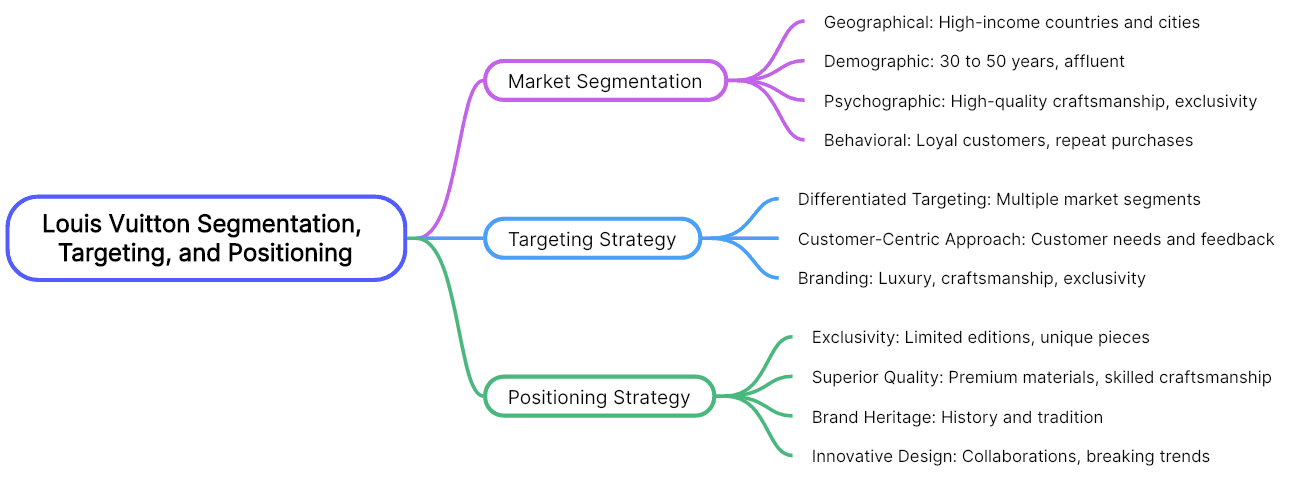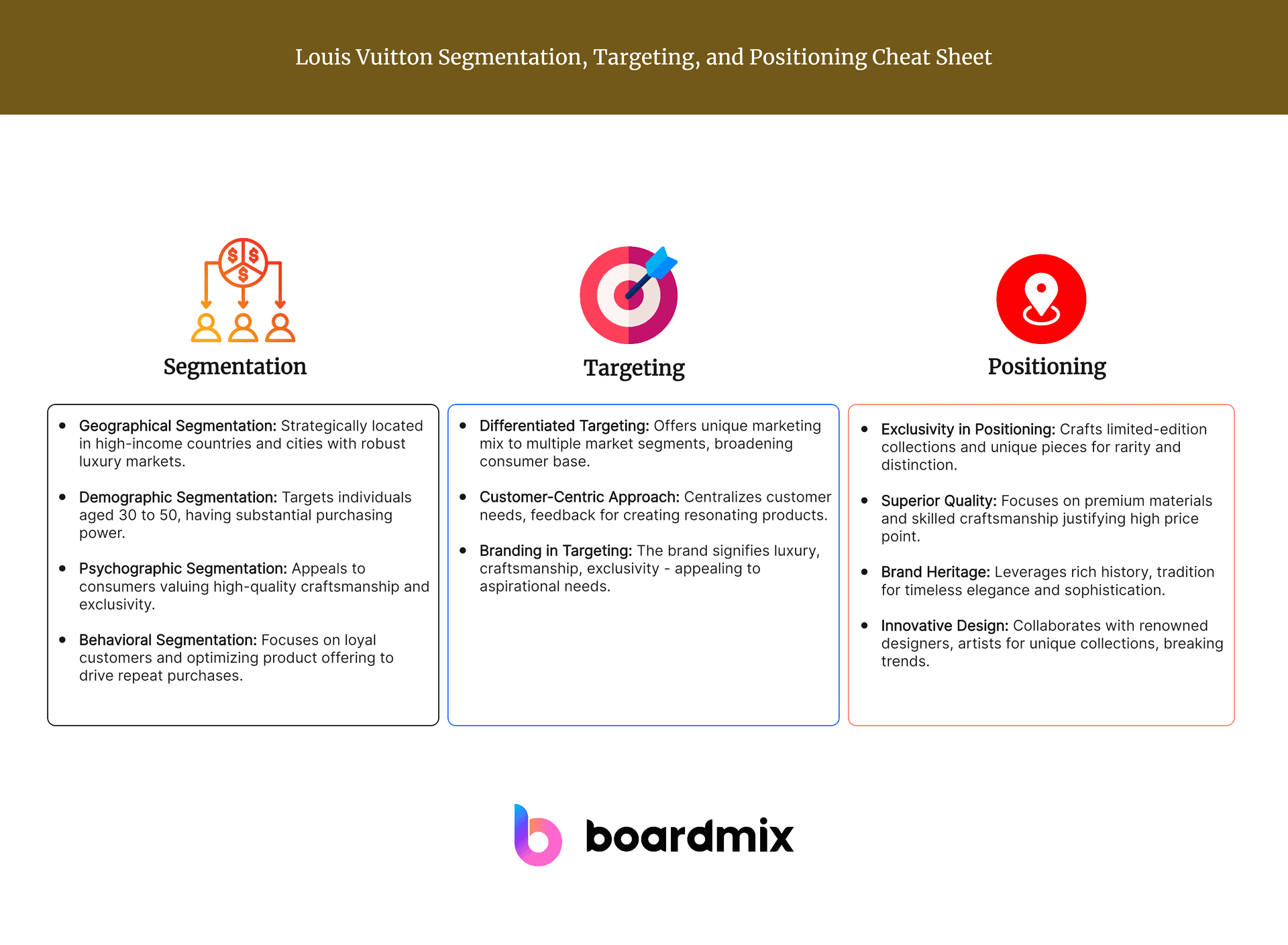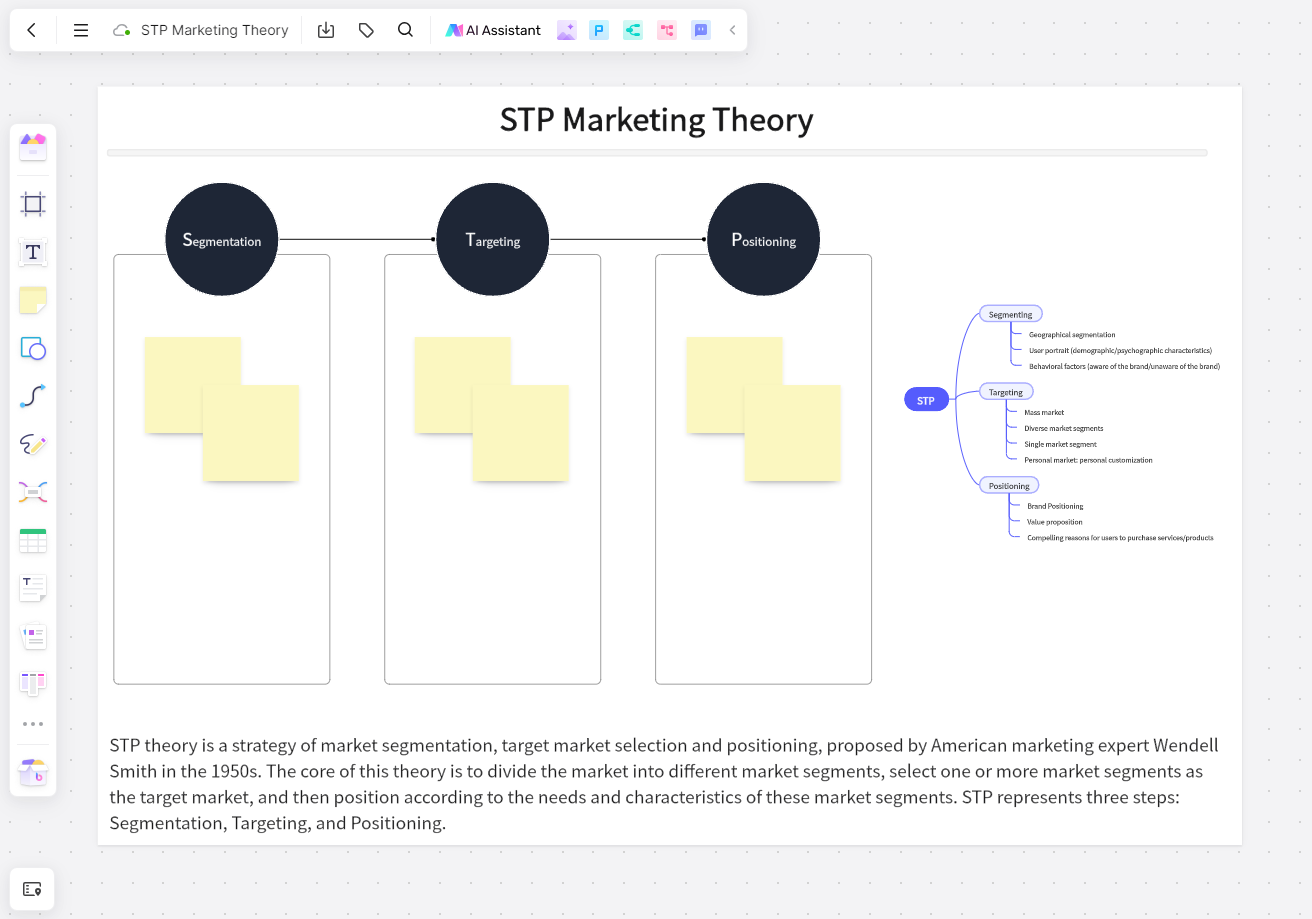Understanding the dynamics of marketing strategies and models can revolutionize the success of a brand. A shining example of segmentation, targeting, and positioning (STP) can be seen in the remarkable success story of Louis Vuitton. The luxury fashion house's strategic market planning is worthy of exploration and admiration.

To understand the complexities of the strategies deployed by Louis Vuitton, we will present an STP mind map. This map intricately lays out the brand's segmentation, targeting, and positioning strategy with engaging graphics for easy comprehension. While the visual aid serves as a clear overview of Louis Vuitton's STP model, the subsequent sections will delve deeper into each component.

Market Segmentation Strategy of Louis Vuitton
Market segmentation is a fundamental concept in strategic marketing, dividing a market into distinct subsets of consumers with common needs or characteristics. Louis Vuitton, an epitome of luxury fashion, meticulously uses market segmentation to tap into the precise needs of its diverse customer base, making it a central pillar of its market strategic planning.
Geographical Segmentation: A Global Reach
When it comes to geographical segmentation, Louis Vuitton has established a broad presence spanning across continents. Its stores are strategically located in high-income countries and cities recognized for their luxury markets, such as Paris, London, Tokyo, New York, and Hong Kong.
These regions are characterized by a high concentration of affluent societies with a strong affinity for luxury brands. The geographical segmentation of Louis Vuitton is designed to cater to these high-potential markets, optimizing the reach and visibility of the brand.
Demographic Segmentation: Catering to the Affluent
In terms of demographic segmentation, Louis Vuitton targets individuals within a specific age and income bracket. Typically, the brand caters to consumers aged between 30 to 50 years - individuals who are established in their careers and have substantial purchasing power.
While income is an essential factor in the demographic segmentation strategy, Louis Vuitton also considers factors like occupation, education level, and social class to better understand and cater to its clientele.
Psychographic Segmentation: Tapping into Lifestyles and Values
For psychographic segmentation, Louis Vuitton focuses on consumers with specific lifestyle preferences and values. The brand resonates with consumers who appreciate high-quality craftsmanship and the exclusivity associated with owning luxury products.
Psychographic factors such as personality traits, lifestyle, attitudes, and values play an instrumental role in determining consumer purchase decisions. By understanding these factors, Louis Vuitton can better predict and influence consumer behavior.
Behavioral Segmentation: Understanding Consumer Behaviour
Finally, Louis Vuitton's behavioral segmentation strategy leverages consumer buying behavior to optimize product offering and marketing strategies. It focuses on understanding customer loyalty, product usage rate, readiness to buy, and benefits sought.
Loyal customers form a significant part of Louis Vuitton's consumer base. To retain these customers, the brand continuously innovates by launching new collections and limited-edition pieces that maintain consumer interest and drive repeat purchases.
Targeting Strategy of Louis Vuitton
After effectively segmenting the market, the next crucial step is targeting. This process involves selecting specific segments to serve based on their attractiveness and the brand's objectives alignment. Louis Vuitton employs a differentiated targeting strategy, designing unique offerings for its diverse audience segments. Let's take a closer look at how Louis Vuitton employs this strategy to stand out in the luxury market.
Differentiated Targeting: Serving Diverse Needs
Louis Vuitton’s targeting strategy is a textbook example of differentiated targeting, where the brand targets multiple market segments, each with a distinct marketing mix. This strategy allows the brand to cater to a variety of customer needs and wants, thereby broadening its consumer base.
For example, Louis Vuitton's iconic monogram bags appeal to customers who seek status symbols - those who find value in showcasing the famous LV logo. On the other hand, Louis Vuitton’s limited-edition collections and exclusive collaborations are aimed at customers who desire uniqueness and exclusivity.
Customer-Centric Strategy: Putting Customers at the Heart
At the core of Louis Vuitton's targeting strategy is a customer-centric approach. The brand not only identifies its potential customers but also makes every effort to understand their needs and preferences. This deep insight allows the brand to create products that resonate strongly with each customer group.
Additionally, the brand takes into account customer feedback to fine-tune its offerings continually. Such a customer-centric approach ensures that each product line from Louis Vuitton meets the high expectations of its discerning clientele.
The Value of Branding in Targeting
Another essential aspect of Louis Vuitton's targeting strategy is the role of branding. Louis Vuitton, as a brand, signifies luxury, craftsmanship, and exclusivity. These attributes align perfectly with the aspirational needs of its target market. The brand name itself becomes an integral part of the targeting strategy as it is the first point of reference for customers seeking luxury goods.
In conclusion, Louis Vuitton's differentiated targeting strategy offers each segment an exclusive experience tailored to their unique needs. By placing customers at the heart of its approach and leveraging its powerful brand name, Louis Vuitton continues to appeal to and engage with a broad consumer base while maintaining its standing in the fiercely competitive luxury market.
Positioning Strategy of Louis Vuitton
Positioning, in marketing, refers to the place a brand occupies in the minds of the customers and how it distinguishes itself from competitors. With myriad luxury brands vying for consumer attention, positioning becomes a defining factor for brands like Louis Vuitton. In this article, we explore the integral components of Louis Vuitton's positioning strategy that has solidified its reputation as an elite, global luxury brand.
Exclusivity: The Louis Vuitton Appeal
One of the core elements of Louis Vuitton's positioning strategy is the emphasis on exclusivity. By crafting limited-edition collections and unique pieces, the brand generates an aura of uniqueness around its products. This exclusivity serves to attract and retain a clientele that values rarity and distinction, reinforcing Louis Vuitton's position as a premier luxury fashion house.
Superior Quality: A Mark of Distinction
At its heart, Louis Vuitton is known for superior quality and craftsmanship. The painstaking attention to detail, the use of premium materials, and the skilled craftsmanship that goes into each product underlines the brand's commitment to quality. This focus on quality not only differentiates Louis Vuitton from its competitors but also justifies the high price point of its products, thereby reinforcing its position in the luxury segment.
Brand Heritage: Building on History
The history and heritage of the Louis Vuitton brand play a crucial role in its positioning strategy. By leveraging its rich history and tradition, the brand cultivates a sense of timeless elegance and sophistication. This historical connection serves as a unique selling proposition, setting Louis Vuitton apart from newer entrants in the luxury market.
Innovative Design: Driving Desirability
Another vital component of Louis Vuitton's positioning strategy is its continual focus on innovative design. The brand regularly collaborates with renowned designers and artists to create unique collections that break traditional boundaries. This constant innovation not only ensures the brand remains at the forefront of fashion trends but also fosters desirability among its customers.
Louis Vuitton's STP Cheat Sheet
We further ease your understanding by distilling these insights into an accessible cheat sheet summarizing Louis Vuitton's STP strategy. The concise guide aims to provide marketing professionals or business enthusiasts with a quick yet comprehensive reference point.

Key Takeaways
Louis Vuitton’s sophisticated STP model offers invaluable insights into the strategic marketing planning of a luxury brand. The brand's segmentation strategy reflects a keen understanding of its diverse consumer base. It employs differentiated targeting to cater to this variety and positions itself as an aspirational symbol in the luxury market.
For organizations seeking to emulate Louis Vuitton's successful STP model, our solution Boardmix offers a practical toolkit. By utilizing our pre-built Market Segmentation Template and STP Analysis Template, you can effectively streamline your strategic marketing planning, drive brand growth, and elevate your positioning in the market.

Boardmix is an instrumental tool designed to tap into your creativity and bring structure to your ideas. With its digital canvas, it empowers users for online collaboration involving sceneries like design research, marketing analysis, business plans, daily meetings, weekly plans, and online education. It offers a one-stop solution of online whiteboards, flowcharts, mind maps, brainstorming, hybrid work, scrum tools, and so on. Boardmix also integrated comprehensive AI-generation features like AI Presentation, AI Image, AI Mind Map, and so on.
In essence, Boardmix stands as a multifaceted tool that brings a new dimension to idea generation and thought organization. With its straightforward interface, collaborative features, adaptive templates, smooth integrations, and budget-friendly pricing, Boardmix Mind Mapping certainly merits a try. Experience how it can transform your mind-mapping process. Try to make your analysis with Boardmix right now!








